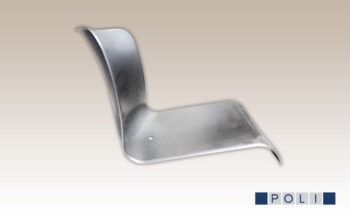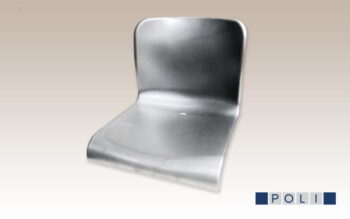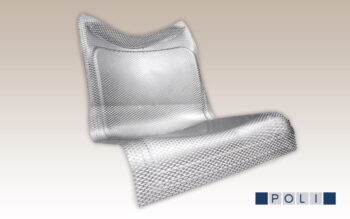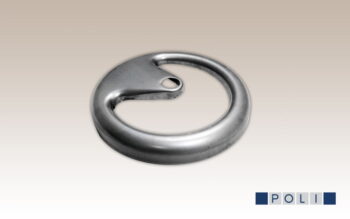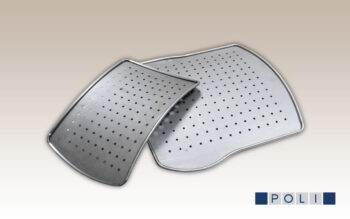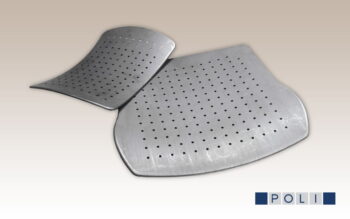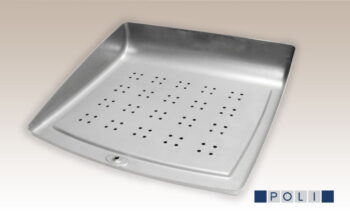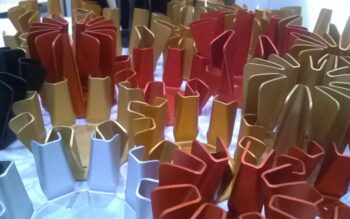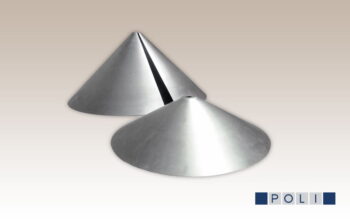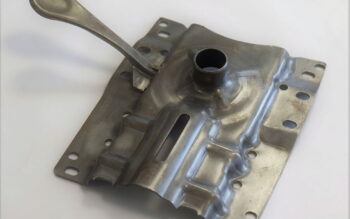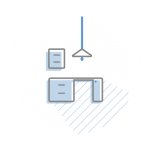Manufacturing of metal components for the lighting and the furniture industries
Great attention to aesthetics is key when manufacturing metal components for the lighting and the furniture industries.
Thanks to its extensive experience in this sector, F.lli Poli provides alternative solutions that allow to cut production costs while ensuring superior quality solutions.
Materials
Extra care is needed when manufacturing components for these sectors. Iron, stainless steel, and aluminium are the materials most commonly used.
As a matter of fact, these materials are particularly suitable to produce fine, aesthetically pleasing products.
Stainless steel can be satin-finished or mirror-polished. It is crucial that both the drawing die and forming do not result in any aesthetic defects in the final product.
Aluminium, on the other hand, can be anodised. Anodizing allows to produce a surface that is extremely pleasing to the eye and guarantees a high degree of protection for the cold-formed product for a long time.
In particular, in the field of lighting, F.lli Poli has created a specific line of dissipation products for LED lamps using pure aluminium.. We therefore combine useful aluminium dissipation with the aesthetics of a beautifully formed shape.
In fact, aluminium is the most suitable material for making the body of LED lamps so that the dissipation of the heat generated by COB is particularly effective.
For the most demanding architects in the furnishing sector, F.lli Poli has carried out studies to produce furnishing items using some very special materials, such as magnesium and titanium. . Thanks to their characteristics, it is possible to produce lightweight technical constructions with the same load-bearing capacity.
F.lli Poli can truly turn the ideas of creative professionals into reality.
Current manufacturing technologies
In the furniture industry, products require particularly complex shapes; the technologies normally used are laser cutting, bending and welding. .
Aesthetically noble materials must be treated after welding though. Stainless steel therefore needs to be ground to even out discrepancies in thickness and to remove any excess weld seams; it also needs treating because of the discoloration resulting from the high temperatures reached during welding. From an operational point of view, these technologies allow to obtain the typical geometries of architectural products, but they are expensive considering industrial production in large quantities, as the cost of welding does not go down with large quantities.
In addition, grinding and pickling are a significant component of the cost of the product that needs a high aesthetic performance.
However, using a press brake implies another important constraint since such machines only allow square bends.
Alternative Technologies
Deep drawing is ideal to meet the demands of architects and designers. This technology, perfectly mastered by F.lli Poli, allows to manufacture components made up of single parts with considerable cost savings.
The bigger the number of items manufactured, the bigger the advantage, as economies of scale are achieved with very high quality of production. If you want to impress your clients with deep-drawing aluminium and stainless steel, please do not hesitate to contact us.
F.lli Poli provides unique support for the optimization of production costs thanks to its 3D laser cutting technology.
This technology allows us to provide our clients with two specific advantages:
- We are effectively able to halve the investment costs for deep drawing dies by 3D laser cutting the deep-drawn product, with complex geometry. No need to invest in a trimming die.
- If several versions of the same product are needed, we can very easily make some production batches with minor modifications to the openings and to the holes. This flexibility allows our clients to create customized products without having to significantly invest in dies.
What makes us unique
F.lli Poli is an active partner aiming at finding ways to support architects searching for increasingly innovative solutions.
One of the biggest problems that architects and creative people face when collaborating with manufacturing companies is that innovative products, in terms of shape or materials, are not normally manufactured because technicians tend to be very conservative when developing products.
At F.lli Poli, we have set one simple rule for ourselves: WE ARE NOT ALLOWED TO SAY IT CANNOT BE DONE!
Together with our client, we experiment with complex solutions and open up the production process to new experiences. This has enabled us to create products that are unique in the world with technologies that, initially, did not seem applicable.
An example of excellence
In collaboration with world-renowned architect Paolo Scagnellato, we have completed an extremely challenging project in the field of furniture seating. That is a chair that has been entirely cold formed, in one piece, from sheet metal.
It is quite common to find this kind of chairs made from plastic, but it is not so easy to make it as a one-piece from sheet metal. It was a huge challenge because chairs formed from sheet metal are normally made by forming the seat and the back separately.
In this case, the architect’s creativity based its aesthetic performance on a single piece that harmoniously developed along a concave/convex surface. The main problem in this application was that any forming imperfections (wrinkles or corrugations) would have created unsightly features in the finished part.
Only thanks to its 50-year experience in designing and manufacturing dies, F.lli Poli successfully created a tool that allowed to turn the architect’s idea into reality, virtually in its entirety.
The photos of the seat can give you an insight into the technological effort made by F.lli Poli’s technicians to come up with the deep-drawing and trimming dies. Also in this case the intermediate step of 3D laser cutting made it possible to minimise the initial investment until mass production began.
And the challenge goes on
After the successful production of a one-piece cold-formed seat by deep-drawing, we were approached to take on an even greater challenge: using the same deep-drawing die for forming a product using expanded metal sheet.
On hearing such a proposal, any engineer would have rejected such a request as, apparently, it seemed impossible to fulfil due to the complex geometry of the component. However, after a series of in-depth technical analyses, it was decided to go ahead with the project and the result of this new adventure was extremely exciting!
Some examples of components:
Fill out the form below for more information




